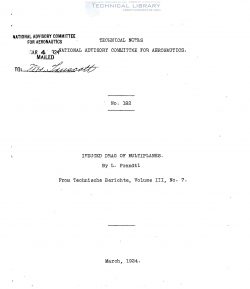naca-tn-182
- Version
- 120 Downloads
- 975.88 KB File Size
- 1 File Count
- November 4, 2016 Create Date
- November 4, 2016 Last Updated
National Advisory Committee for Aeronautics, Technical Notes - Induced Drag of Multiplanes

The most important part of the resistance or drag of a _
wing system, the induced drag, can be calculated theoretically,
when the distribution of lift on the individual wings is known3;_:‘
The calculation is based upon the assumption that'the lift on
the wings is distributed along the wing in proportion to the 1
ordinates of a semi—ellipse (Fig. l). Formulas and numerical
tables are given for calculating the drag.
During experiments with extra large wing models in the
thtingen wind tunnel, it was found that, with an increase in
the characteristic number,* the wing—section drag** became an_”
ever smaller part of the total drag- In the case of very large
characteristic numbers, it consisted only of frictional drag,
provided a good wing section was experimented with and that the
'angle of attack came within the range to whidh the particular
wing section was adapted.
From the results thus established, a theoretical calculation
of the induced drag of multiplanes attains a high practical
value, for, since the frictional drag can be approximately esti—
mated, it is also possible to calculate the total drag by com—
puting the induced drag. It follows that the total drag, con—
formably with the properties of induced drag, depends only-upon
the outer contour dimensions of the wing system and upon the
distribution of the lift on its various parts. It also follows
that the wingrsection is of importance only in so far as it must
be suitably selected for the purpose in view.
| File | Action |
|---|---|
| naca-tn-182 Induced Drag of Multiplanes.pdf | Download |
Comment On This Post